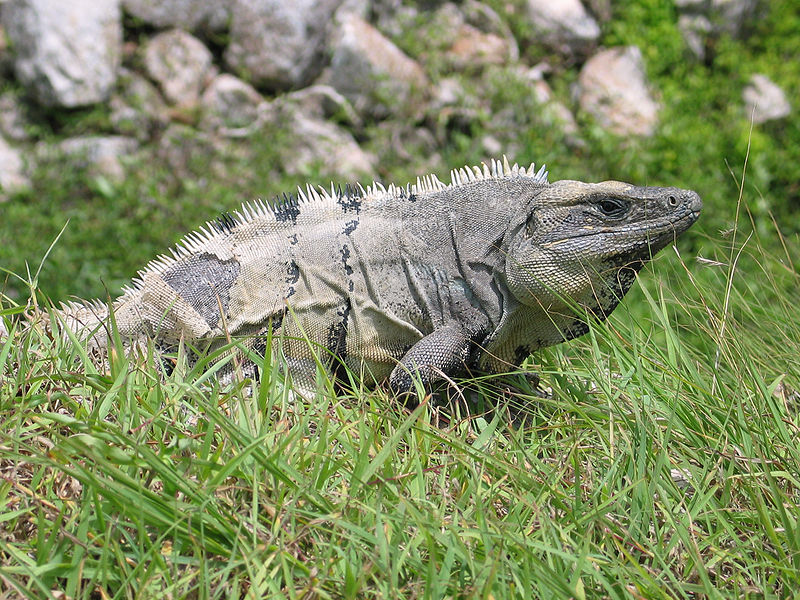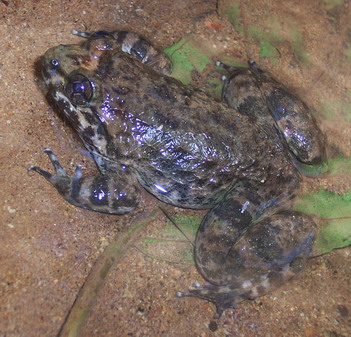Classified within the family Iguanidae we find some of the most the world’s most popularly kept lizards, such as the Green Iguana (Iguana iguana) and the Chuckwalla (Sauromalus obesus). As we will see, this diverse group is also populated by a number of oddities as well – rare island dwellers and lizards that dive into icy ocean waters to munch on seaweed, for example.
(Iguana iguana) and the Chuckwalla (Sauromalus obesus). As we will see, this diverse group is also populated by a number of oddities as well – rare island dwellers and lizards that dive into icy ocean waters to munch on seaweed, for example.
Species Diversity
The family Iguanidae originally contained over 700 species. Recent work by taxonomists at the American Museum of Natural History has left the family with 36 species.
The 36 family members range from the United States south through Central America to Paraguay, and also inhabit the Galapagos Islands, West Indies and Fiji.
Habitats
Most are terrestrial but a number are habitat specialists – i.e. the rock-dwelling Chuckwallas, the arboreal Green Iguana and the ocean-dwelling Marine Iguana (Amblyrhnchus cristatus).
All are diurnal, oviparous (egg-laying) and largely herbivorous, although some invertebrate prey is taken, especially by young animals. Iguanids range in size from the 6 inch Desert Iguana to the 6.5 foot Green Iguana.
A Seagoing Iguana
 The Marine Iguana must surely be the strangest lizard in the family, if not the world. Indigenous to Ecuador’s Galapagos Islands, it feeds entirely on submerged marine algae (“seaweed”).
The Marine Iguana must surely be the strangest lizard in the family, if not the world. Indigenous to Ecuador’s Galapagos Islands, it feeds entirely on submerged marine algae (“seaweed”).
The water surrounding these tropical islands is very cold, arising as it does from the Humboldt Current. Under normal circumstances, a lizard entering such water would be rendered immobile within minutes. The Marine Iguana, however, slows its heart’s action to ½ of the normal rate when diving for food, thus limiting the amount of blood that circulates to its outer surfaces (where it would cool rapidly).
After feeding, Marine Iguanas increase their heart rate and bask in the sun to warm up. Other adaptations to a marine existence include nasal glands that expel seawater, partially webbed feet and a laterally compressed tail.
The unique ticks that parasitize these ocean-going iguanas are hunted by brilliantly-colored crabs that clamber over the lizards’ bodies as they bask – one can only imagine what the first people to view such a scene might have thought!
Endangered Island Dwellers
All 8 species of Rhinoceros Iguana (Cyclura spp.) are limited to specific islands in the Caribbean, such as Cuba, Hispaniola, Jamaica, the Caymans and the Bahamas, and all are critically endangered. Threats include hunting, habitat loss due to development and the grazing of feral goats, and predation by introduced dogs, cats and rats. A number of zoos and governments are working on breeding, predator removal and reintroduction programs.
Several species of Rhinoceros Iguanas are also being bred in the pet trade, a fortunate circumstance which has helped to remove collecting pressure on wild populations. Large and highly intelligent, captive Rhinoceros Iguanas require room-sized enclosures or outdoor aviary-type pens.
Feral, Pet and Food Trade Iguanas
The Green Iguana, long a pet trade staple despite its large size, is also an important food animal and is farmed throughout Latin America. Escaped and released pets have established large breeding populations in southern Florida and on the Florida Keys.
Native to Central and South America, several of the 14 species of Spiny-tailed Iguanas (Ctenosaura spp.)are common in the pet trade. Escapees have established breeding populations in southern Florida and on several of the Florida Keys.
Further Reading
Information about each member of the family Iguanidae is posted at here.
In the future I’ll write about the captive care of individual Iguanids, including my favorites, the chuckwalla and desert iguana.
Iguana in Mexico image referenced from wikipedia and originally posted by Keith Pomakis
Marine Iguanas image referenced from wikipedia and originally posted by Aquaimages
 That Reptile Blog – Reptile, Amphibian and Exotic Pet Care and Information
That Reptile Blog – Reptile, Amphibian and Exotic Pet Care and Information

 The newly discovered frog is largely aquatic, and apparently catches birds that come to the water’s edge to drink – quite a unique feeding strategy for a frog (I once saw a surprising film of African Side-necked Turtles catching doves in this manner).
The newly discovered frog is largely aquatic, and apparently catches birds that come to the water’s edge to drink – quite a unique feeding strategy for a frog (I once saw a surprising film of African Side-necked Turtles catching doves in this manner). (Iguana iguana) and the Chuckwalla (Sauromalus obesus). As we will see, this diverse group is also populated by a number of oddities as well – rare island dwellers and lizards that dive into icy ocean waters to munch on seaweed, for example.
(Iguana iguana) and the Chuckwalla (Sauromalus obesus). As we will see, this diverse group is also populated by a number of oddities as well – rare island dwellers and lizards that dive into icy ocean waters to munch on seaweed, for example. The Marine Iguana must surely be the strangest lizard in the family, if not the world. Indigenous to Ecuador’s Galapagos Islands, it feeds entirely on submerged marine algae (“seaweed”).
The Marine Iguana must surely be the strangest lizard in the family, if not the world. Indigenous to Ecuador’s Galapagos Islands, it feeds entirely on submerged marine algae (“seaweed”). 1950’s and 60’s, huge numbers of baby Spectacled Caimans (Caiman crocodylus), dubbed “alligators”, were sold to tourists visiting Florida. In fact, I was presented with just such a creature by my grandfather. As the story went, the “gators” wound up in sewers after being flushed or dropped there when they became ill or too large for their owners to manage.
1950’s and 60’s, huge numbers of baby Spectacled Caimans (Caiman crocodylus), dubbed “alligators”, were sold to tourists visiting Florida. In fact, I was presented with just such a creature by my grandfather. As the story went, the “gators” wound up in sewers after being flushed or dropped there when they became ill or too large for their owners to manage. creatures to brief lives, if ever they were there.
creatures to brief lives, if ever they were there. Happily, as time went on I was able to work with 15 or so species of crocodilians in zoos and the wild. Please see the attached photos – the beast charging me is a marsh crocodile, Crocodylus palustris, the long-snouted fellow being led into the net is an Indian gharial, Gavialis gangeticus, and the white specimen is an albino American alligator, Alligator mississippiensis.
Happily, as time went on I was able to work with 15 or so species of crocodilians in zoos and the wild. Please see the attached photos – the beast charging me is a marsh crocodile, Crocodylus palustris, the long-snouted fellow being led into the net is an Indian gharial, Gavialis gangeticus, and the white specimen is an albino American alligator, Alligator mississippiensis.